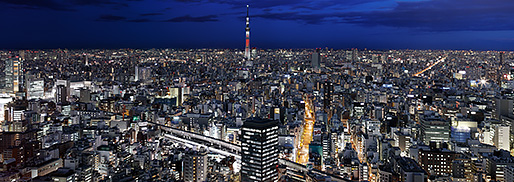The Origin of Tokyo
My work up to this point has mainly featured eastern Tokyo, yet for my latest project I’ve switched focus to the city’s center. Including such central locations as the Imperial Palace (formerly the site of Edo Castle) adds a historical layer to the previous series, Tokyo Twilight Zone, which had focused primarily on the eastern part of Tokyo where I was born and raised. In the title, The Origin of Tokyo, the word “origin” refers to both the geographical place where Edo Castle was built (when present-day Tokyo was still called Edo), and to the geological features of the land that the city was established upon. Geological properties influence the way people design cities, and the combination of human activities, the history of the land itself, and the history of the city that grows upon it, eventually generates that city’s distinctive atmosphere – its “soul” so to speak. An “origin” is an underlying quality that greatly influences human behavior.
In modern cities that continuously and drastically change on a superficial level, there are few places that have managed to retain their original features quite as much as the location of the Imperial Palace has done. Situated at the edge of the Musashino Plateau (formerly a coastal area at the time of the sea level rise during the Jomon period, about 6,000 years ago), Edo Castle faced the sea when Tokugawa Ieyasu built the city of Edo. The location is thus a boundary in the true sense of the word, and this boundary is exactly where the city of Tokyo emerged from. Against the backdrop of a frightening evolution - from the vast wasteland framed by Mt. Fuji and the surrounding mountains over the great flux of time, to the modern-day Musashino Plateau with all of its high-rise buildings - the Imperial Palace seems to be running counter to that evolution as it retains the land’s original geological features whilst retreating backwards into the forest. Tokyo is a city that lives and breathes this complicated flow of time.
Back when Edo was conceived and the castle was built, the priest Tenkai – in his function as Tokugawa Ieyasu’s advisor – set up a religious protective barrier from the kimon (northeastern point) to the urakimon (southwestern point) of the castle. Today, the unscientific idea of kimon and urakimon may seem rather unrealistic to us, but it’s a story that is connected to the place’s history and to its geological and natural properties, and can even be said to have informed Tokyo’s contemporary city planning and is thus an integral part of the foundation of Tokyo. The fact that Tokyo Sky Tree was erected in the kimon direction northeast of the Imperial Palace, while Tokyo Tower was built upon a spiritual area of land which lies approximately in the urakimon direction of the palace, can perhaps be attributed to such local geological and historical factors.
The emergency staircases and rooftops from which these photographs were taken are boundaries as well. They are places somewhere between the ordinary and the extraordinary; places between heaven and earth that harbor the danger of slipping from this life into the afterlife by taking just a few steps forward. When looking down on the city at the boundary between day and night, from an intermediate elevation much lower than that of aerial or satellite photography, one can grasp the expansion of the city as a whole, whilst simultaneously recognize all of the little details and traces of human activity. Emerging from all of this is a surge of dynamic energy that defines the very soul of this particular place - the origin of Tokyo.





